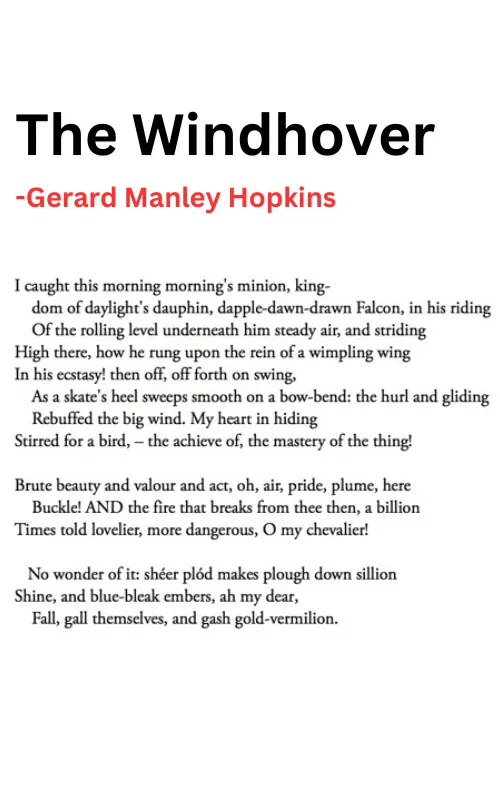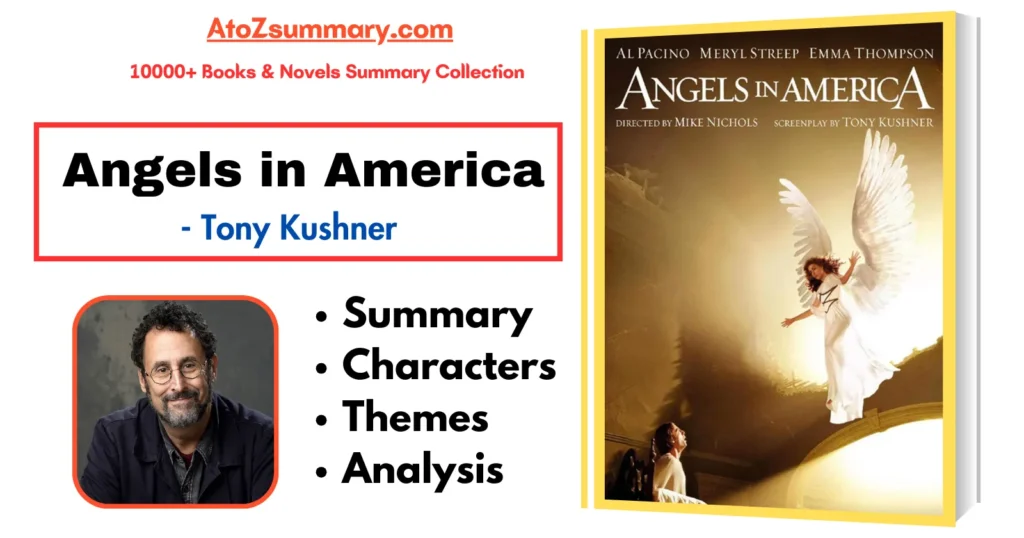About Poem: The Windhover
| Title | The Windhover |
| Poet | Gerard Manley Hopkins |
| Date of Publication | May 30, 1877 |
| Genre | Sonnet |
| Form | Petrarchan sonnet |
| Subject | A kestrel falcon, also known as a windhover |
| Setting | A field, with the windhover hovering overhead |
| Genre | Sonnet |
| Form | Petrarchan sonnet |
| Themes | Nature, spirituality, beauty |
| Structure | 14 lines divided into an octave (first 8 lines) and a sestet (last 6 lines) |
| Rhyme Scheme | ABBAABBA CDECDE |
Themes: The Windhover
- Nature’s Beauty ➤ The poem celebrates the beauty and grace of a bird in flight.
- Spirituality ➤ It suggests a connection between nature and the divine, seeing the bird as a symbol of God’s presence.
- Awe and Wonder ➤ The poem conveys a sense of awe and wonder in the face of the natural world.
- Inspiration ➤ It inspires the reader to appreciate the small, magnificent moments in nature and find spiritual meaning in them.
The Windhover Poem
I caught this morning morning’s minion, king-
dom of daylight’s dauphin, dapple-dawn-drawn Falcon, in his riding
Of the rolling level underneath him steady air, and striding
High there, how he rung upon the rein of a wimpling wing
In his ecstasy! then off, off forth on swing,
As a skate’s heel sweeps smooth on a bow-bend: the hurl and gliding
Rebuffed the big wind. My heart in hiding
Stirred for a bird, – the achieve of, the mastery of the thing!
Brute beauty and valour and act, oh, air, pride, plume, here
Buckle! AND the fire that breaks from thee then, a billion
Times told lovelier, more dangerous, O my chevalier!
No wonder of it: shéer plód makes plough down sillion
Shine, and blue-bleak embers, ah my dear,
Fall, gall themselves, and gash gold-vermilion.
Watch Full Poem Summary of “The Windhover” on YouTube
The Windhover Summary & Analysis
Stanza 1
The poem begins with the poet addressing the bird, a windhover, as “king of the skies.” This establishes the majesty and importance of the bird. The poet describes how the bird is striding through the rolling air with a firm and controlled flight. This suggests a sense of command and nobility.
Stanza 2
The second stanza continues to describe the bird’s flight. It is referred to as “the rolling level underneath him steady air.” The bird’s mastery over the air is emphasized, as if it moves effortlessly through the medium. The poet uses vivid imagery to depict the bird’s wing flaps as “buckle, the underpinning,” which adds to the sense of strength and stability.
Stanza 3
In this stanza, the poet introduces the idea of the windhover’s “heart in hiding.” The bird’s heart, its deepest essence, is hidden from sight as it soars. The poet also likens the bird’s action to a knight’s shield, suggesting a sense of chivalry and valor. This reinforces the idea of the bird as a noble and regal figure in the sky.
Stanza 4
The fourth stanza continues to explore the bird’s flight, describing its motion as “sheer plod.” This suggests that the bird’s movement is heavy and deliberate, almost like a horse’s slow trot. The poet employs rich and sensory language to depict the bird’s actions, emphasizing its power and grace.
Stanza 5
This stanza introduces the concept of the bird’s “fall.” The bird, in its majestic flight, momentarily folds its wings and descends. This descent is compared to a stone falling in a well, creating a visual and auditory contrast to the previous soaring flight. The poet’s keen observation and vivid imagery capture this moment of descent with precision.
Stanza 6
The final stanza of the poem carries a significant shift in tone. It expresses a sense of triumph and praise. The “Brute beauty” of the bird’s flight is highlighted, with the word “brute” suggesting a raw, unrefined beauty. The poem ultimately suggests that in this act of nature, in the windhover’s flight, there is a manifestation of divine grace. The bird is seen as a symbol of God’s presence in the world, and the poet is in awe of this revelation.
FAQs: The Windhover
What is the meaning of the poem The Windhover?
The poem celebrates the beauty, power, and grace of nature, as seen in the kestrel falcon.
What poetic techniques are in Windhover?
The poetic techniques in Windhover are: vivid imagery, symbolism, and alliteration to create a powerful portrait of a kestrel falcon in flight.
What is the message behind the poem?
The message behind the poem is that even in nature’s beauty, we can find a connection to something divine and wonderful.
What is the symbolism of wind?
In the poem “The Windhover”, the wind symbolizes the power and support that lifts the bird in flight.
How is Windhover a religious poem?
The Windhover is a religious poem because it sees the bird’s flight as a sign of God’s presence and grace in nature.










![The Catcher In The Rye Summary, Themes & Characters [by J. D. Salinger] The Catcher In The Rye Summary, Themes & Characters [by J. D. Salinger]](https://atozsummary.com/wp-content/uploads/2023/06/The-Catcher-In-The-Rye-Summary-Themes-Characters-by-J.-D.-Salinger.webp)
